SCIENCE AND TECHNOLOGY IN ANCIENT ROME

Roman tower crane Scientific instruments found at Pompeii have included stone sun dials, small portable sun dials made of bone and variety of measuring instruments. Ancient Romans would be familiar with the most of the tools in modern toolbox. The Romans had their version of a plane, bronze folding “ regula” (measuring devices), hand-forged spikes (instead of nails), drills, chains, axes, mattocks, crowbars, handcuffs, combs, heated curling tongs and presses.
The Roman also pioneered the use of ceramics for things like bathtubs and drainage pipes. But for all the genius they never invented or used the wheelbarrow, kites, or cast iron (the Chinese did).
The Romans invented revolving human- and animal-powered cage wheels (images of them appear in Pompeii) and developed sophisticated slave- and donkey-powered rotary grain mills. Cage wheels powered cranes that lifted blocks of stone into place during the construction of tall structures. Later similar cranes were use in the construction of medieval cathedrals.
Pumping systems were used in wells and irrigation systems and to pump water out of leaky boats. Sometimes water moving stumps were used to move water considerable distances and heights. In one Roman mine a cascade of eight pairs of scoop wheelers raised water almost a hundred feet.
Roman engineers developed upright water wheels of the underwater paddlewheel variety. They used only the horizontal motion of the water, which didn't generate that much power. Water was raised to troughs above a river and waterwheels were used to grind corn.
Categories with related articles in this website: Ancient Greek and Roman Philosophy and Science (33articles) factsanddetails.com; Ancient Greek and Roman Religion and Myths (35 articles) factsanddetails.com; Ancient Greek History (48 articles) factsanddetails.com; Ancient Greek Art and Culture (21 articles) factsanddetails.com; Ancient Greek Life, Government and Infrastructure (29 articles) factsanddetails.com; Early Ancient Roman History (34 articles) factsanddetails.com; Later Ancient Roman History (33 articles) factsanddetails.com; Ancient Roman Life (39 articles) factsanddetails.com; Ancient Roman Art and Culture (33 articles) factsanddetails.com; Ancient Roman Government, Military, Infrastructure and Economics (42 articles) factsanddetails.com
Websites on Ancient Greece and Rome:
Internet Ancient History Sourcebook: Greece sourcebooks.fordham.edu ; Internet Ancient History Sourcebook: Hellenistic World sourcebooks.fordham.edu ; BBC Ancient Greeks bbc.co.uk/history/; Canadian Museum of History historymuseum.ca; Perseus Project - Tufts University; perseus.tufts.edu ; ; Gutenberg.org gutenberg.org;
British Museum ancientgreece.co.uk;
Illustrated Greek History, Dr. Janice Siegel, Department of Classics, Hampden–Sydney College, Virginia hsc.edu/drjclassics ;
The Greeks: Crucible of Civilization pbs.org/empires/thegreeks ;
Oxford Classical Art Research Center: The Beazley Archive beazley.ox.ac.uk ;
Ancient-Greek.org ancientgreece.com;
Metropolitan Museum of Art metmuseum.org/about-the-met/curatorial-departments/greek-and-roman-art; The Ancient City of Athens stoa.org/athens;
The Internet Classics Archive kchanson.com ; Internet Ancient History Sourcebook: Rome sourcebooks.fordham.edu ; Internet Ancient History Sourcebook: Late Antiquity sourcebooks.fordham.edu ; Forum Romanum forumromanum.org ;
“Outlines of Roman History” forumromanum.org; “The Private Life of the Romans” forumromanum.org|; BBC Ancient Rome bbc.co.uk/history;
The Roman Empire in the 1st Century pbs.org/empires/romans;
The Internet Classics Archive classics.mit.edu ;
Bryn Mawr Classical Review bmcr.brynmawr.edu;
De Imperatoribus Romanis: An Online Encyclopedia of Roman Emperors roman-emperors.org;
Cambridge Classics External Gateway to Humanities Resources web.archive.org/web;
Ancient Rome resources for students from the Courtenay Middle School Library web.archive.org ;
History of ancient Rome OpenCourseWare from the University of Notre Dame /web.archive.org ;
United Nations of Roma Victrix (UNRV) History unrv.com
Ancient Inventions
"Ancient Inventions” is a book by Peter James and Nick Thorpe (Ballantine Books, 1995) is a compendium of curiosities dating from the Stone Age to 1,000 A.D., the book argues that just because our ancestors lived long ago and had less technology at their disposal does not mean they were any less intelligent than we are. [Source: Laura Colby, New York Times, May 16, 1995]
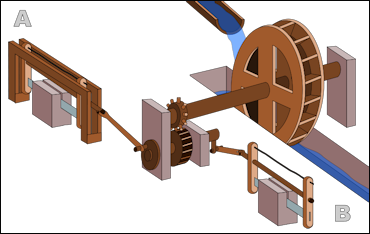
waterwheel In fact, many of the inventions that we believe belong to our own modern era already existed hundreds, sometimes even thousands of years ago. Our ancestors were not quaint superstitious people mystified by the problems of everyday life; they were, much as we are today, hard at work on ingenious solutions. The authors have broken down the inventions into different categories such as medicine; food, drink and drugs; transportation and communications; and military technology, making the book easy to thumb through in the coffee-table style, rather than one to be read from start to finish.
We learn that our ancestors used birth control — everything from a condom to a rudimentary form of the pill — abused drugs ranging from hallucinogenic mushrooms to cocaine, and were entertained by sport, music and theater. We see homes many thousands of years old with plumbing, indoor ovens, and many other conveniences we associate with our own era.
But by far the most interesting parts of the book are those that provide examples of technology, rather than everyday objects. Inhabitants of present-day Iraq, for instance, had developed a form of electric battery about 2,000 years ago, using a clay jar that contained a copper rod sealed with asphalt. The so-called Baghdad Battery, discovered in 1936, was probably used by jewelers to electroplate bronze jewelry. Medicine, including brain surgery, the making of artificial limbs and plastic surgery, is one of the most hair-raising chapters. Early military technology, including a "machine gun" in the form of a crossbow that could fire 20 arrows in less than 15 seconds, is also covered.
Reconstructing Roman Machines
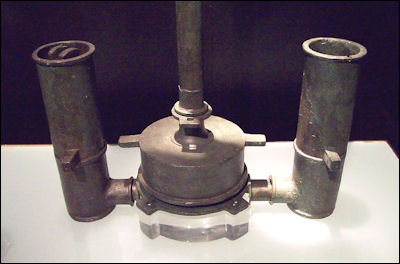
Roman hydraulic pump Adam Hart-Davis wrote for the BBC: “A waterwheel was built by Henry and John Russell in an attempt to copy the remains of a wheel at Dolaucothi in Wales, which appears to have been used to pump water out of the gold mine. The reconstructed wheel was twelve feet high and one foot wide, and when I got it going by walking up the outside like a treadmill, I was able to lift a bathful of water - 150 litres - every minute. According to the experts this is about twice the amount the Romans would have lifted. However, I'm a heavy chap and was only just able to lift this much water. A puny British slave of 1800 years ago certainly would not have been heavy enough. [Source: Adam Hart-Davis, BBC, February 17, 2011 |::|]
“Therefore it seems likely that the Roman wheel was only about eight inches wide, rather than a foot. Also I could only operate the wheel for a couple of minutes before collapsing for a rest, whereas the slave would probably have been expected to carry on for hours, even in the dark and underground. |::|
“The Russell brothers also built the most wonderful wine press, a Roman fire pump, with which we managed to put out a small fire, and weirdest of all a Roman odometer, to measure the distance travelled along a road. Each time the four-foot wheel turned, it engaged once with a cogwheel carrying 400 teeth. This meant that the big cogwheel rotated exactly once every Roman mile, and at this point a small stone - a calculus - dropped into a box. So at the end of the trip count the calculi and you know how many miles you have covered! |::|
I am amazed at how efficient the Romans were as engineers and organisers. They were not brilliant innovators, and in the 400 years that they occupied Britain they failed to make many technological advances. However, the might of the Roman empire stemmed from the brilliant use they made of the technology they brought with them. And for me, pride of place among the technology must go to that waterwheel at Dolaucothi and those latrines on Hadrian's Wall.” |::|
Sundials and Waterclocks in Ancient Rome
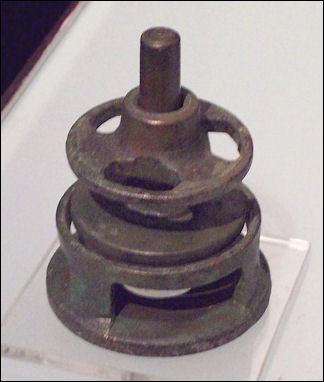
Roman hydraulic pump
Although sun dials had been around at least since 1500 B.C. in ancient Egypt they became more sophisticated and common place under the Romans. Roman sundials not only mapped out hours they cut them into halves and quarters. Not everyone was happy about the advancement. The Roman playwright Plautus wrote in the 2nd century B.C.: “The gods confound the man who first found out how to distinguish the hours. Confound him, who in this place set up a sundial, to cut and hack up my days so wretchedly into small pieces!”
Harold Whetstone Johnston wrote in “The Private Life of the Romans”: “The place of our clock was taken in the peristylium or garden by the sundial (solarium), such as is often seen nowadays in our parks and gardens; this measured the hours of the day by the shadow of a stick or pin. It was introduced into Rome from Greece in 268 B.C. About a century later the water-clock (clepsydra) was also borrowed from the Greeks. This was more useful because it marked the hours of the night as well as of the day and could be used in the house. It consisted essentially of a vessel filled at a regular time with water, which was allowed to escape from it at a fixed rate, the changing level marking the hours on a scale. As the length of the Roman hours varied with the season of the year and the flow of the water with the temperature, the apparatus was far from accurate. Shakespeare’s reference in Julius Caesar (II, i, 192) to the striking of the clock is an anachronism.” [Source: “The Private Life of the Romans” by Harold Whetstone Johnston, Revised by Mary Johnston, Scott, Foresman and Company (1903, 1932) forumromanum.org |+|]
Long before they were applied to time, seconds and minutes were used to represent units on a circle or arc. In the Greco-Roman era, Ptolemy used the units, based on the Babylonian base-60 system, on his maps. In the Middle Ages, minutes used on circular clock dials. Seconds as a time measurement were introduced in the late 17th century when clocks accurate enough to tick off seconds were developed.
Like their Athenian counterpart, the Roman waterclock was a bowl with a hole near the bottom that measured about 20 minutes. These devised were used in courts and government legal proceedings to limit the speaking time of lawyers, officials and orators. In Rome, the expression "to lose water" meant wasting time and "to grant water" meant to allocate a lawyer more time. Longwinded speakers in the Senate were chided that "their water should be taken away" By the time water clocks were perfected in Europe they were soon replaced by swinging pendulum and spring activated clocks.
Roman Calendar
Originally the Roman year began on March 25 and had 10 months (six 30-day months and four 31-day months) and a 60-day winter stretch that appears to have been ignored. In the 7th century B.C. the second Roman king, Numa Pompilius, added two months, January and February, and they became the beginning of the year. The year was still only 355 days though. A century later a 13th month was added that yielded a year with 366¼ days.
By Caesar's time spring and the vernal equinox began in mid May. In 153 B.C., the Senate declared that the year would begin on January 1st but the changes didn't take place until 46 B.C. when Julius Caesar aimed to set the record straight.
Early calendars had no year 0 because the Romans hadn't devised zero. The year of Christ' birth was designated as 1 A.D. Orthodox Christians continued to observe Easter according to Julian calendar. Other Christians now mark Easter by the Gregorian Calendar.
After spending time with Cleopatra in Alexandria and becoming exposed to the Egyptian calendar, Caesar returned home to Rome in 47 B.C. and adapted the Egyptian calendar to the Roman one. Caesar added 90 days to 46 B.C. which lasted 445 days and became known as the "Year of Confusion."
Julian Calendar
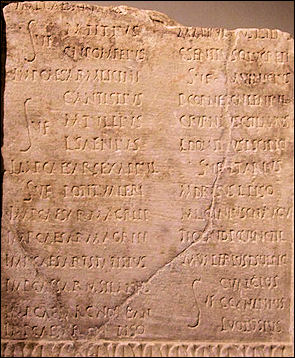
Roman calendar
The Julian calendar, established in 46. B.C. by Julius Caesar and worked out by the Alexandrian astronomer Sosgenes, had 12 months, 365 days and one leap day every four years between February 23 and February 24. It was only 11 minutes and 14 seconds out of synch with the actual solar year (one revolution of the earth around the sun). Initially Romans read Caesar's edict for the new system wrong and leap day occurred every third year. Augustus rectified the error in 8 B.C.
The 11 minutes and 14 second error may not seem like much but over hundreds of years it adds up. By Columbus's time, the vernal equinox was occurring on March 11th instead of March 21st and farmers no longer relied on the calendar for planting and harvesting their crops. In 1582 the Julian calendar was updated and replaced by the Gregorian calendar devised by Pope Gregory XIII.
Kevin Short wrote in the Daily Yomiuri, “Caesar's solar calendar has become the world standard, but in most traditional societies the phases of the moon formed the basis for tracking the passage of time. The problem with a moon-only calendar, however, is that a period of 12 lunar months contains only about 354 days (an average lunation is 29.5 days), which is 11 days less than the 365 days it takes the earth to revolve around the sun. A lunar calendar thus loses time against the actual seasons at a pace of about 11 days each year. To correct this discrepancy, most lunar calendars incorporate a system for inserting extra months, called leap or intercalary months, at fixed intervals. The mathematics, which were worked out by the fifth century B.C. Greek astronomer Meton, produce a figure of seven extra months every 19 years. The Coligny calendar indicates that the ancient Celts employed a 30-year period, over which a total of 11 intercalary months were inserted. [Source: Kevin Short, Daily Yomiuri, October 14, 2010]
Gregorian Calendar
Pope Gregory XIII (1502-1585) is the pope who gave us the Gregorian calendar that we use today. When he took over the papacy the Julian calendar was 11 days off out of sync with the seasons.
In 1582, Pope Gregory inaugurated the calendar that would bear his name by ordaining that the day after October 4 was October 15. This aligned the seasons with the calendar but caused an uproar among servants who demanded a full month's wage but were refused it by their employers. The Gregory calendar also started the year on January 1st. To make sure the seasons and dates stayed aligned, leap years were omitted from years marking the beginning of a century. The calendar we follow today is virtually the same as the Gregorian calendar except from time to time top international time keeping bodies add a leap second to ensure that the time kept on earth is aligned with cosmos. ["The Discoveres" by Daniel Boorstien]
As a statement against the power of the Roman church some groups refused to go along with the Gregorian calendar. The eastern Orthodox Church held on to the Julian calendar for its calculations of Eastern Orthodox holidays. Russian didn't stop using the Julian calendar until the Bolshevik revolution in 1917. After the French Revolution, around the same time the metric system was established, the French introduced a day with ten hours, an hour made up of 100 minutes with 100 seconds, and a week consisting of ten days. The time keeping system lasted for 13 years until 1805 when Napoleon brought back the old seve-day-week, 24-hour, 60-second minute system. In 1929 the Soviet Union tried to establish a calendar based on five-day-weeks with one-day weekends that were organized into six-week-months, but by 1940 they too returned to the Gregorian calendar. ["The Discoveres" by Daniel Boorstien]
Gregory decreed that lead days would not be added to in centennial years not divisible by 400. By this criteria 1700, 1800 and 1900 were not leap years but 2000 was. This helped to get rid of an 11-minute a year discrepancy that existed between calendar time and real time.
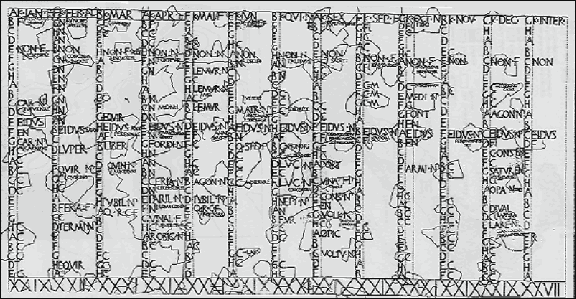
Roman calendar
Hours of the Day in Ancient Rome
Harold Whetstone Johnston wrote in “The Private Life of the Romans”: The daylight itself was divided into twelve hours (horae); each was one-twelfth of the time between sunrise and sunset and varied therefore in length with the season of the year. “In the same way the hours may be calculated for any given day, if the length of the day and the hour of sunrise are known, but for all practical purposes the old couplet will serve: The English hour you may fix,/ If to the Latin you add six. When the Latin hour is above six it will be more convenient to subtract than to add. The length of the day and hour at Rome at different times of the year is shown in the following table:
Month and Day: December 23
Length of Day: 8 hours 54 minutes
Length of Hour: 44 minutes' 30 seconds
[Source: “The Private Life of the Romans” by Harold Whetstone Johnston, Revised by Mary Johnston, Scott, Foresman and Company (1903, 1932) forumromanum.org |+|]
Month and Day: February 6
Length of Day: 9 hours 50 minutes
Length of Hour: 49 minutes 10 seconds
Month and Day: March 23
Length of Day: 12 hours 00 minutes
Length of Hour: 1 hour 00 minutes 00 seconds
Month and Day: May 9
Length of Day: 14 hours 10 minutes;
Length of Hour: 1 hours 10 minutes 50 seconds
Month and Day: June 25
Length of Day: 15 hours 6 minutes
Length of Hour: 1 hours 15 minutes 30 seconds
Month and Day: August 10
Length of Day: 14 hours 10 minutes
Length of Hour: 1 hours 10 minutes 50 seconds
Month and Day: September 25
Length of Day: 12 hours 00 minutes;
Length of Hour: 1 hour 00 minutes 00 seconds
Month and Day: November 9
Length of Day: 9 hours 50 minutes;
Length of Hour: 49 minutes 10 seconds
Roman Hours in the Summer and Winter
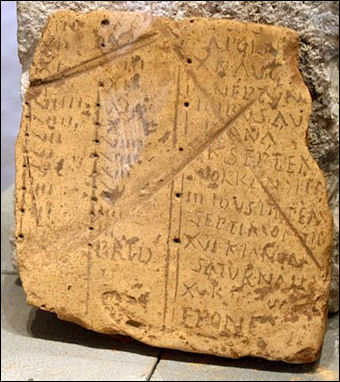
Roman calendar
Taking the days of June 25 and December 23 as respectively the longest and shortest of the year, the following table gives the conclusion of each hour for summer and winter:
Sunrise
Summer: 4 hours 27 minutes 00 seconds
Winter: 7 hours 33 minutes 00 seconds
[Source: “The Private Life of the Romans” by Harold Whetstone Johnston, Revised by Mary Johnston, Scott, Foresman and Company (1903, 1932) forumromanum.org |+|]
1st Hour
Summer: 5 hours 42 minutes 30 seconds
Winter: 8 hours 17 minutes 30 seconds
2nd Hour
Summer: 6 hours 58 minutes 00 seconds
Winter: 9 hours 2 minutes 00 seconds
3rd Hour
Summer: 8 hours 13 minutes 30 seconds
Winter: 9 hours 46 minutes 30 seconds
4th Hour
Summer: 9 hours 29 minutes 00 seconds
Winter: 10 hours 31 minutes 00 seconds
5th Hour
Summer: 10 hours 44 minutes 30 seconds
Winter: 11 hours 15 minutes 30 seconds
6th Hour
Summer: 12 hours 00 minutes 00 seconds
Winter: 12 hours 00 minutes 00 seconds
7th Hour
Summer: 1 hours 15 minutes 30 seconds
Winter: 12 hours 44 minutes 30 seconds
8th Hour
Summer: 2 hours 31 minutes 00 seconds
Winter: 1 hours 29 minutes 00 seconds
9th Hour
Summer: 3 hours 46 minutes 30 seconds
Winter: 2 hours 13 minutes 00
10th Hour
Summer: 5 hours 2 minutes 00 seconds
Winter: 2 hours 58 minutes 00 seconds
11th Hour
Summer: 6 hours 17 minutes 30 seconds
3 hours 42 minutes 30 seconds
12th Hour
Summer: 7 hours 33 minutes 00 seconds
Winter: 4 hours 27 minutes 00 seconds
Ancient Measurements
Many of the ancient units of measurement were for practical reasons based parts of the body. The digit (width of a finger), the palm (the width of four fingers), the foot and the cubit (the distance from the tip of the middle finger to the elbow) were all measurements of length. The "pace" (the precursor of the yard and meter) was equal to one large step and "fathom" (roughly six feet) was the distance between two outstretched hands. ["The Creators" by Daniel Boorstin]
In ancient times a lot of the standard formulas that modern engineers and architects use to measure stress and balance had not yet been invented. Most building were but together with knowledge learned through trial and error. One of the first scientific principals of architecture — that a the base of column should be equal to one sixth of its height — was based on the observation that the size of a person's foot is one sixth of his height. [Ibid]
Roman Measurements and Numbers
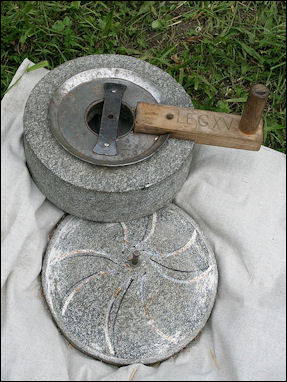
handmill from first century The Romans took measuring to new levels. They kept standards for weights and measures in a temple in Rome. In accordance with Roman law, people in all parts of the empire had to use weights like those of the standards. The Romans developed graded glass bottles for measuring liquids, elaborate scales and land survey equipment. They even devised an odometer" (a cart with a system of cogs attached to the back axle that caused a stone to drop through a hole into a box with a loud thunk every 1,860 yards to mark places where milestones should be deposited.
Rome introduced the “ mille passus” based on 1000 paces (double steps), or the length of 1000 soldiers, lined up two paces apart. It was equal to 5000 Roman feet or 4865 modern feet (about 95 percent the length of a modern mile). The modern mile comes to us from the Romans via Britain. In the late 16th century, Queen Elizabeth I added 280 feet so the mile would be exactly eight "furrow-longs" or furlongs.⋆
Other Roman liner measurements: 1) the digitus (0.73 inch); 2) the Roman foot (0.973 foot); 2) the gradus (2.43 feet); and 4) the actus (116.4 feet). Among Roman weight measurements were: 1) the as (.72 pound); 2) the uncia (420 grains); 3) the libra (12 unciae); 4) the talent (125 librae); 5) the bes (.48 pound); 6) the denarius (0.16 grains); 7) the obolus (8.77 grains); and 8) the scrupulum (17.53 grains).
The Greeks and Romans were unable to make the breakthrough of the concept of zero. The first Old World Culture believed to have figured it out was the ancient Hindus.
Roman numerals were cumbersome. Engineers and architects didn’t use them. Instead they used “simple geometry to establish the desired dimension for their designs, creating standard lengths of chain or rope. Then they used a compass and straightedge to align the architectural elements in correct and pleasing proportions.”
Why We Use Arabic Numerals Instead of Roman Ones
Arabic numerals were introduced into Europe during the Middle Ages by Italian merchants, and in reality they were actually Hindu numerals that were introduced to the Middle East from India by Arab traders. What made the Hindu numbers so appealing is that the value of number was determined by its position which was not true with Roman numbers. "1," for example, could represent "1," "10," "100" or "1,000,000,000,000" depending on its place in relation to the zeros.
This mathematical advancement was made possible by the Hindu understanding of the concept of zero. The only other ancient culture to understand this concept was the Mayas. The main advantage of Roman numerals was that addition and subtraction in some case was very simple. If you subtract 21 (XXI) from 83 (LXXXIII), for example, all you have to do is remove the XXI from LXXXIII, leaving LXII (62). This technique is not as simple if you take away 49 (XLIX) from 50 (L).
Iron and Ancient Metallurgy

Pompeii tools Metal was worked in a shaft furnace and shaped with an anvil and hammer, The Greeks made iron stronger by quenching in cold water while the metal was still hot. The Romans learned how to temper it. The Greeks gained access to tin needed to make bronze when they colonized what is now Marseilles.
The Iron Age began around 1,500 B.C. It followed the Stone Age, Copper Age and Bronze Age. North of Alps it was from 800 to 50 B.C. Iron was used in 2000 B.C. Improved iron working from the Hittites became wide spread by 1200 B.C.
Iron was made around 1500 B.C. by the Hitittes. About 1400 B.C., the Chalbyes, a subject tribe of the Hitittes invented the cementation process to make iron stronger. The iron was hammered and heated in contact with charcoal. The carbon absorbed from the charcoal made the iron harder and stronger. The smelting temperature was increased by using more sophisticated bellows.
Iron — a metal a that is harder, stronger and keeps an edge better than bronze — proved to be an ideal material for improving weapons and armor as well as plows (land with soil previously to hard to cultivate was able to be farmed for the first time). Although it is found all over the world, iron was developed after bronze because virtually the only source of pure iron is meteorites and iron ore is much more difficult to smelt (extract the metal from rock) than copper or tin. Some scholars speculate the first iron smelts were built on hills where funnels were used to trap and intensify wind, blowing the fire so it was hot enough to melt the iron. Later bellows were introduced and modern iron making was made possible when the Chinese and later Europeans discovered how to make hotter-burning coke from coal. [Source: "History of Warfare" by John Keegan, Vintage Books]

Archscrew Metal making secrets were carefully guarded by the Hittites and the civilizations in Turkey, Iran and Mesopotamia. Iron could not be shaped by cold hammering (like bronze), it had to be constantly reheated and hammered. The best iron has traces of nickel mixed in with it. [Ibid]
About 1200 BC, scholars suggest, cultures other than the Hittites began to possess iron. The Assyrians began using iron weapons and armor in Mesopotamia around that time with deadly results, but the Egyptians did not utilize the metal until the later pharaohs. Lethal Celtic swords dating back to 950 BC have been found in Austria and its is believed the Greeks learned to make iron weapons from them. [Ibid]
Glass Making
Modern glass blowing began in 50 B.C. with the Romans, but origins of glass making go back even further. Pliny the Elder attributed the discovery to Phoenician sailors who placed a sandy pot on some lumps of alkali embalming powder from their ship. This provided the three ingredients needed for glass making: heat, sand and lime. Although it is interesting story, it is far from true.
The oldest glass so far discovered is from site in Mesopotamia, dated to 3000 B.C., and glass in all likelihood was made before that. The ancient Egyptians produced fine pieces of glass. The eastern Mediterranean produced especially beautiful glass because the materials were of fine quality.
Around the 6th century B.C. the “core glass method” of glass making from Mesopotamia and Egypt was revived under the influence of Greek ceramics makers in Phoenicia in the eastern Mediterranean and then was widely traded by Phoenician merchants. During the Hellenistic period, high quality pieces were created using a variety of techniques, including the cast glass and mosaic glass.
Roman Glass Making
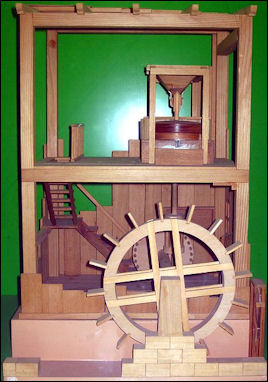
The Romans made drinking cups, vases, bowls, storage jars, decorative items and other object in a variety of shapes and colors. using blown glass. The Roman, wrote Seneca, read "all the books in Rome" by peering at them through a glass globe. The Romans made sheet glass but never perfected the process partly because windows weren’t considered necessary in the relatively warm Mediterranean climate.
The Romans made a number of advancements, the most notable of which was mold-blown glass, a technique still used today. Developed in the eastern Mediterranean in the 1st century B.C., this new technique allowed glass to be made transparent and in a wide variety of shapes and sizes. It also allowed glass to be mass produced, making glass something that ordinary people could afford as well as the rich. The use of mold-blown glass spread throughout the Roman empire and was influenced by different cultures and arts.
With the core-form mold-blown technique, globs of glass are heated in a furnace until they become glowing orange orbs. Glass threads are wound around a core with a handling piece of metal. Craftsmen then roll, blow and spin the glass to get the shapes they want.
With the casting technique, a mold is formed with a model. The mold is filled with crushed or powdered glass and heated. After cooling down, the plank is removed from the mold, and the interior cavity is drilled and exterior is well cut. With the mosaic glass technique, rods of glass are fused, drawn and cut into canes. These canes are arranged in a mold and heated to make a vessel.
Pliny the Elder
Pliny the Elder was one of the world's greater chroniclers. An avowed workaholic, he wrote his historical works and encyclopedia with "20,000 noteworthy facts" in his free time while he worked as an army officer, bureaucrat, governor in several provinces and admiral in Rome's largest fleet. Pliny was born in northern Italy in A.D. 23. Little is known about his early life. Pliny the Younger was his nephew. [Source: Jerry Dennis, Smithsonian, November 1995]
"What made Pliny's achievement possible," wrote classicist Lionel Casson, "was a fanatical way he had of making every minute count. He burned the midnight oil literally: his standard routine was to get in hours of study before the break of day, when his official responsibilities began."
Pliny often began his day at midnight and worked 20 or 24 hours a day. He kept a pen and writing tablet next his plate so he could jot notes while eating. When he traveled about the streets of Rome he insisted on being carried by slaves in litter, instead of wasting his time walking, so he could continue reading and work on route. His personal secretary was outfit with a special long sleeve tunic that enabled him to take notes even in bad climate weather and he often worked while getting a massage at the Roman baths.
Pliny was obsessed with the written word and is also credited with introducing the a table of contents. He poured over countless Greek and Latin texts, even ordering his secretary to read to him even while he was dining or taking a bath. He believed books were the ultimate repository of knowledge, “our civilization — or at any rate our written records — depends especially on the use of writing materials,” he wrote.
Works by Pliny the Elder
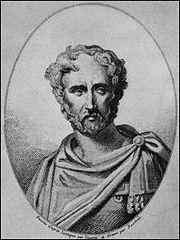
Pliny the Elder Pliny once wrote: "Nature, that is to say, life is my subject.” “Natural History” , Pliny's 37-book encyclopedia, referenced 2,000 volumes by at least 1000 authors. It contained facts about astronomy, geology, meteorology, geography, anthropology, botany, medicine, zoology, art, helmets with ostrich plumes, types of mattresses and the difficulties of sponge diving. He offered tips of raising bees and figs, described how ro make glue from oxhides, gave advice on choosing onions and reported heaps of fantastic and erroneous information.
In “ Natural History” , Pliny described a race of headless people whose eyes were on their shoulders, two-headed people who communicated by barking, fast-running people with 16 toes and backward feet; one-legged people that got around by hoping; big-footed people who reclined on their backs and used their feet as umbrellas; and mouthless people who drew their nourishment from roots.
Animals in “ Natural History “ included elks lacking knee joints, lions with human faces, scorpions with tails that fed on people, and snakes that preyed on elephants and were capable bursting rocks with their breath. “Natural History” was a bestsellers and assumed as fact through the Middle Ages. Pliny also wrote “The Art of Using a Javelin on Horseback” , “Life of Pomponius Secundus” , “The History of Wars in Germany” , “The Students” , “ Linguistic Queries” and “History of Our Own Times” .
Pliny the Elder and the Eruption of Vesuvius
While most people headed as quickly as they could away from Pompeii, the very curious Roman historian and naturalist Pliny the Elder headed straight for it. At the time of the eruption Pliny and his nephew, Pliny the Younger, were across the Bay of Naples, 15 miles from Vesuvius and 20 miles away from Pompeii. The elder Pliny considered the eruption a novelty and, taking a Roman fleet with him, sailed towards Pompeii. The nephew initially stayed behind and wrote an account of what happened, apparently pieced together from his own observations and the accounts of survivors.
Pliny the Younger wrote that Pliny the Elder "had been out in the sun, and taken a cold bath" and "my mother drew his attention to a cloud of unusual size and appearance...It was not clear from which mountain the cloud was rising. Later we knew it was Vesuvius...My uncle's scholarly acumen saw at once it was important enough for a closer inspection and he ordered a boat to be made ready."
"He was entirely fearless...he hurried to the place everyone else was hastily leaving...Ashes were already falling, hotter and thicker as the ships drew near." His boat was bombarded with fiery ashfall and blocked with floating rafts of pumice but eventually he made it to Stabiae which was about the same distance from Pompeii as Pompeii was from Vesuvius.
To calm his friends Pliny told them "the broad sheets of fire and leaping flames" were "nothing but the bonfires left by peasants." Later, while his companions debated whether to stay in their house or flee, Pliny slept soundly through the first night of the eruption. When the houses starting shaking violently, they put pillows on their heads to protect themselves from falling rocks.”
Pliny the Elder died in the eruption of Vesuvius. He advised calm when the volcano began erupting and stayed in Pompeii even though he had enough warning to escape. He went outside the day after the initial eruption, on August 25, with a pillow tied to his head. Some think that Pliny the Elder died choked by ash after landing in the beach near Pompeii.
Pliny the Younger wrote that August 25, was "blacker and denser than any ordinary night." Violent waves made escape by sea impossible. Pliny grew tired and repeatedly asked for cold water. Then suddenly the "flames and smell of sulphur" drove his companions to flight. The elder Pliny collapsed, perhaps from a heart attack or from breathing in toxic fumes, and two days later his body was found on a beach at Stabiae "entire an uninjured...its postured that of sleeping, rather than a dead man."
Image Sources: Wikimedia Commons, The Louvre, The British Museum
Text Sources: Internet Ancient History Sourcebook: Rome sourcebooks.fordham.edu ; Internet Ancient History Sourcebook: Late Antiquity sourcebooks.fordham.edu ; Forum Romanum forumromanum.org ; “Outlines of Roman History” by William C. Morey, Ph.D., D.C.L. New York, American Book Company (1901), forumromanum.org \~\; “The Private Life of the Romans” by Harold Whetstone Johnston, Revised by Mary Johnston, Scott, Foresman and Company (1903, 1932) forumromanum.org |+|; BBC Ancient Rome bbc.co.uk/history/ ; Perseus Project - Tufts University; perseus.tufts.edu ; MIT, Online Library of Liberty, oll.libertyfund.org ; Gutenberg.org gutenberg.org Metropolitan Museum of Art, National Geographic, Smithsonian magazine, New York Times, Washington Post, Los Angeles Times, Live Science, Discover magazine, Times of London, Natural History magazine, Archaeology magazine, The New Yorker, Encyclopædia Britannica, "The Discoverers" [∞] and "The Creators" [μ]" by Daniel Boorstin. "Greek and Roman Life" by Ian Jenkins from the British Museum.Time, Newsweek, Wikipedia, Reuters, Associated Press, The Guardian, AFP, Lonely Planet Guides, “World Religions” edited by Geoffrey Parrinder (Facts on File Publications, New York); “History of Warfare” by John Keegan (Vintage Books); “History of Art” by H.W. Janson Prentice Hall, Englewood Cliffs, N.J.), Compton’s Encyclopedia and various books and other publications.
Last updated October 2018
